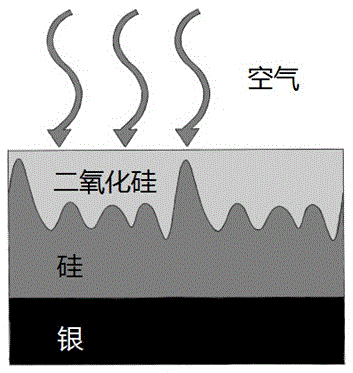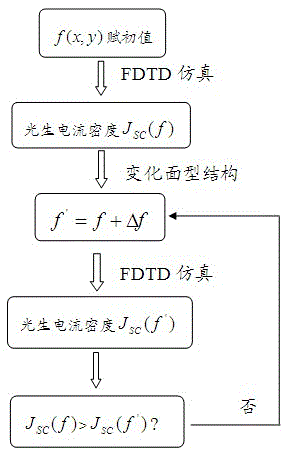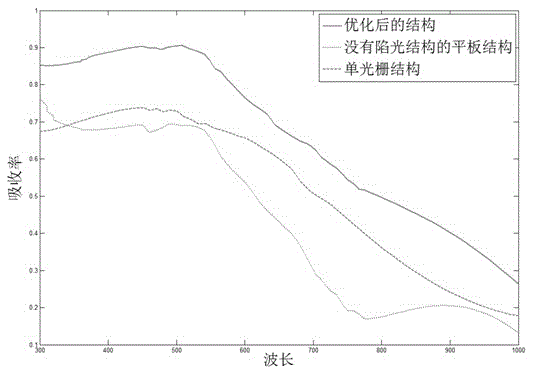Multiscale light trapping structures for thin-film solar cells
A technology of solar cells and light-trapping structures, applied in circuits, photovoltaic power generation, electrical components, etc., can solve problems such as limited spectrum and angle sensitivity, achieve wide-spectrum absorption, improve conversion efficiency, and avoid Auger recombination
- Summary
- Abstract
- Description
- Claims
- Application Information
AI Technical Summary
Problems solved by technology
Method used
Image
Examples
Embodiment 1
[0033] Set n=3, the initialization period is 1100nm, according to the formula needs to be optimized (a 1 ,b 1 ,a 2 ,b 2 ,a 3, b 3 ,), according to the specific construction steps above, the optimized parameters obtained after two hundred iterations are shown in the following table:
[0034] A 1
A 2
A 3
B 1
B 2
B 3
n
Λ
0.8
1.22
0.7
1.62
0.6
1.5
3
1100nm
[0035] At this point the surface formula is:
[0036] F ( x ) = Σ ( 0.8 * sin ( 2 π * 1 ...
Embodiment 2
[0039] Set n=4, the initialization period is 1300nm, according to the formula
[0040] Therefore, it is necessary to optimize (a 1 ,b 1 ,a 2 ,b 2 ,a 3, b 3 ,a 4, b 4 ,) According to the specific construction steps above, the optimized parameters obtained after two hundred iterations are shown in the following table:
[0041] A 1
A 2
A 3
A 4
B 1
B 2
B 3
B 4
n
Λ
0.9
1.1
0.98
1.05
0.9
1.1
0.9
1.02
4
1300nm
[0042] At this point the surface formula is:
[0043] F ( x ) = Σ ( 0.9 * sin ( 2 π ...
PUM
 Login to View More
Login to View More Abstract
Description
Claims
Application Information
 Login to View More
Login to View More - R&D
- Intellectual Property
- Life Sciences
- Materials
- Tech Scout
- Unparalleled Data Quality
- Higher Quality Content
- 60% Fewer Hallucinations
Browse by: Latest US Patents, China's latest patents, Technical Efficacy Thesaurus, Application Domain, Technology Topic, Popular Technical Reports.
© 2025 PatSnap. All rights reserved.Legal|Privacy policy|Modern Slavery Act Transparency Statement|Sitemap|About US| Contact US: help@patsnap.com



